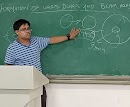Relativity
World's most famous equation E=mc2 Is now simplified!!!
In
my previous article related to relativity I explained the basic meaning of relativity and the difference between general and special relativity. If you
haven’t read it then my suggestion is to read it first and then come here.
Until Einstein, mass and energy were seen as
completely separate things. His work proved that the principles of the
conservation of mass and energy are part of a bigger, more unified conservation
of mass-energy. Matter, therefore, can be turned into energy and vice versa due
to the fundamental connection between them. That is, frankly, amazing.
E=mc2
This formula states that the equivalent energy (E)
can be calculated as the mass (m) multiplied by the speed of light (c = ~3×108 m/s)
squared. Similarly, anything having energy exhibits a corresponding mass m given
by its energy E divided by the speed of light squared c2.
Because the speed of light is a very large number in everyday units, the
formula implies that even an everyday object at rest with a modest amount of
mass has a very large amount of energy intrinsically.
In relativity, removing energy is
removing mass, and for an observer in the centre of mass frame, the
formula m = E/c2 indicates how
much mass is lost when energy is removed. In a nuclear reaction, the mass of
the atoms that come out is less than the mass of the atoms that go in, and the
difference in mass shows up as heat and light with the same relativistic mass as
the difference (and also the same invariant mass in the centre
of mass frame of the system). In this case, the E in the
formula is the energy released and removed, and the mass m is
how much the mass decreases. In the same way, if m increases then E also
increases.
You may be now thinking that: What if the mass of
any particle is 0 like photon???
If you are thinking like this, then I can
assure you that you are thinking like a
physicist…..
Coming
to the answer: See, the particles like photon has no rest mass. They has
relativistic mass.
Okay
don’t panic….see my post regarding the difference between rest and relativistic mass.
For
now, just accept that there is two types of mass: rest mass and relativistic.
So, their relativistic
mass is simply their relativistic energy, divided by c2,
or mrel = E/c2.The energy for photons is E = hf,
where h is Planck's constant and f is
the photon frequency. This frequency and thus the relativistic energy are
frame-dependent.
Was Einstein the only person who figured out the
relation between energy and mass???
The simple is no. But, if I speak technically then;
yes.
In 1873, Nikolay Umov pointed out a relation
between mass and energy for ether in the form of Е = kmc2, where 0.5
≤ k ≤ 1. The writings of Samuel Tolver Preston, and a 1903 paper by Olinto
De Pretto, presented
a mass–energy relation.
Bartocci (1999) observed that there were
only three degrees of separation linking
De Pretto to Einstein, concluding that Einstein was probably aware of De
Pretto's work. Also, Gustave Le Bon in 1905 speculated that atoms could release
large amounts of latent energy. Among all these scientists Einstein figured out the correct formula and that's why he is credited with its discovery.
 |
| Nikolay Umov |
In my upcoming articles, I am going to simplify the difference between rest and relativistic mass so, don’t forget to subscribe to our website and follow me on social media for updates…..
You can directly talk with me on Instagram
To meet more physics Enthusiasts please join our Facebook Page
To meet more physics Enthusiasts please join our Facebook Page
Also for latest updates of my posts join me on Twitter
Thanks for reading.....
See you next time!!!
-Ratnadeep Das Choudhury
Founder and Writer of The Dynamic Frequency













0 Comments